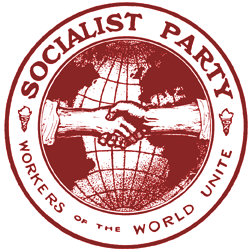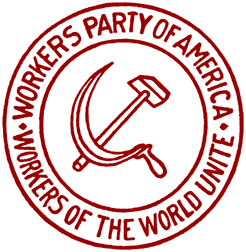Bohemian (Czech) Language Federations history (1890s-1930s)
BOHEMIAN (CZECH) FEDERATIONS
The Early Bohemian Radical Movement in America
There seems to have been some sort of Bohemian (Czech) radical movement which emerged iin the United States late in the 1890s.
It is unclear at what point the various Bohemian branches combined into a national organization; this seems to have taken place at some point in the first half of the first decade of the 20th Century.
In 1900, the Czech daily newspaper Spravedlnost [Justice] was established, with the paper going to daily status in 1906. The publication did not run as a profitable operation, as it was periodically forced to cover its operating costs covered by collections and profits from fundraisers such as bazaars, pictnics, and dances.
In 1908, Bohemian branches in Cleveland, Ohio, began to publish a weekly newspaper, Americke Delnicke Listy [American Workingmen’s News]. A second weekly called Pravo was pubished by the same group beginning in 1912. These Cleveland papers were published in their own printshop, which also handled other job printing work.
In 1911, the New York Bohemian socialist organization together with the Czech trade unions started a weekly newspaper called Obrana [Defense]. This New York group also published sundry other literature in the Czech language, including books and pamphlets.
[fn. Josef Novak, “Report of Bohemian Section"in Proceedings: National Convention of the Socialist Party, pp. 242-243.]
The Bohemian Section of the Socialist Party of America
The Bohemian Section of the Socialist Party of America was affiliated with the SPA in December of 1911, with the organization’s first Translator-Secretary, Josef Novak, assuming his post on Dec. 13 of that month. At the time of its formation, the Bohemian Section had 37 branches with a membership of about 800 spread across 10 states.
During the first three months of its affiliation, the Bohemian Section added seven new branches, bringing the total to 44, with a membership of 1,164 in 11 states. Nearly a third of the organizational structure — 13 of the 44 sections — was located in the city of Chicago.
[fn. Josef Novak, “Report of Bohemian Section"in Proceedings: National Convention of the Socialist Party, pp. 242-243.]
The Socialist Party continued to have a Bohemian Federation through the 1920s. In September 1921 there was a crisis in the organization leading to its temporary withdrawal — details remain unavailable at this time.
In the first quarter of 1931 a meeting of the Federation in Chicago adopted a new proclamation of principles, reorganized the administration of the Federation, and arranged for a national conference of the Federation to be held in Cleveland in July 1931.
Charles Glaser was the Secretary of the SP’s Bohemian Federation in 1930-31.
[fn. Proletarec [Chicago], v. 26, no. 1232 (April 23, 1931), pg. 8.]
Bohemian group of the United Communist Party of America
In December 1920 there was only one primary party unit ("Group") of the United Communist Party using the Czech language. It was located in Chicago.
[fn: DoJ/BoI Investigative Files, NARA M-1085, reel 940, doc. 501 — downloadable below.]
The Czecho-Slovak Federation of the Workers Party of America
The Bohemian Federation of the Socialist Party split at some point in the 1921-22 period. The left wing leaving the Socialist Party established themselves as the “Czecho-Slovak Marxist Federation"
In June of 1922, the Czecho-Slovak Marxist Federation submitted the question of affilation with the Workers Party of America to a vote of its members. In July the Executive Committee of the group further took up the question, voting nearly unanimously to affiliate with the WPA. The organization published an official organ called Spravdelost from an office located at 1825 S Loomis St., Chicago.
[fn. Comintern Archive, f. 515, op. 1, d. 146, l. 168; d. 147, l. 73.]
Downloads
1908
MAY
“Report of Committee on Foreign Speaking Organizations to the National Convention of the Socialist Party, May 17, 1908.” Committee report to the 1908 SPA Convention in Chicago, delivered by S.A. Knopfnagel. The Committee advocated the acceptance of all foreign language organizations seeking affiliation with the Socialist Party, subject to 5 conditions: “(1) They are composed of Socialist Party members only. (2) Any foreign speaking organization having a national form of organization of its own be recognized only if all the branches composing this organization having been chartered by the national, state, or local Socialist Party organizations, and pay their dues to the respective Socialist Party organizations. (3) No foreign speaking organization asking the Socialist Party for recognition shall issue their own particular national, state, or local charters. Same to be issued only by the respective organizations of the Socialist Party, as the case may require. (4) All foreign speaking organizations affiliated with the Socialist Party must and shall conform in every respect with the Socialist Party national, state, and local constitutions, platforms, and resolutions. (5) They should function only as agitation, education, and organization bureaus of the Socialist Party.”Includes an amendment made from the floor but not published in the SP’s Official Bulletin (probably due to incompetence rather than malice) prohibiting the refusal of admission to the SPA on account of race or language.
1912
MAY
“Report of Bohemian Section to the Socialist Party National Convention, May 1912,”by Josef Novak. The Bohemian (Czech) Section of the Socialist Party of America was formally organized in December 1911, with 37 branches and about 800 paid members. This report to the 1912 Indianapolis Convention of the SPA by the first Translator-Secretary of the Bohemian Section details a bit of organizational history and lists the location of the various branches of the organization, which had grown to 44 branches in 11 states with 1,164 members at the time of this report.
undetermined date
“Membership Series by Language Federation for the Workers Party of America. ‘Dues Actually Paid’ — January to December 1923.”Official 1923 data set of the Workers Party of America, compiled from a document in the Comintern Archive. This series shows a great numerical dominance of the WPA by its Finnish Federation, accounting for a massive 42.8% of the average monthly paid membership of the organization (6,583 of 15,395). The total of the English language branches is the 2nd strongest amongst the federations (7.6%) followed by the South Slavic (7.5%), Jewish [Yiddish language] (6.9%), and Lithuanian (6.0%) Federations. In all, there were statistics kept for 18 different language groups of the WPA in 1923, including the English and the barely organized Armenian sections.
“Initiation Stamps Sold by Federation for the Workers Party of America. January to December 1923.”Official 1923 data set of the Workers Party of America, compiled from a document in the Comintern Archive. This series once again (repeating the previous published 1924 series) shows a schizophrenic pattern of stamp sales among language groups . Some federations clearly did not collect the initiation fees called for in the WPA constitution at all (Jewish, German, Latvian) while at the same time the quantities sold via the English branches are ridiculously high. Over 53% of the initiation stamps sold for the entire WPA were credited to the English branches — nearly three times as many initiations than there were average duespayers in those English branches! Even assuming a significantly higher than average “membership churn”rate for English branches, there is clearly some other unexplained phenomenon at play in these English branch initiation stamp sale figures...
undetermined date
“Membership Series by Language Federation for the Workers Party of America. ‘Dues Actually Paid’ — January to December 1924.”Official 1924 data set of the Workers Party of America, compiled from a document in the Comintern Archive. This shows a continued numerical dominance of the Workers Party of America by its Finnish-language federation, averaging a paid membership of 7100 (41% of the entire organization) for the year 1924. Impressive growth is shown by the Yiddish-language ("Jewish") federation, which moved to the third largest language group in the WPA in 1924. The English branches comprised the second largest language group in the WPA, but still remained just 11% of the overall organization. The South Slavic federation (predominately Slovenian and Croation) was the 4th largest language group in the WPA, topping the Russian, Lithuanian, and Ukrainian federations.
“Initiation Stamps Sold by Federation for the Workers Party of America. January to December 1924.”Official 1924 data set of the Workers Party of America, compiled from a document in the Comintern Archive. An extremely interesting monthly series in which two unexplained anomalies are apparent: (1) The failure of at least 8 of the WPA’s 18 language sections to make more than a token effort to collect the $1 initiation fee and obvious similar behavior (to lesser degree) among branches of other language groups; (2) A preposterously large sale of 5,264 initiation stamps to “English”branches, which averaged a paid membership of just 1909 over the course of the year. Either there was a revolving door in the English branches that was entirely dissimilar to the situation in any other language group of the WPA; or there was some sort of effort to collect initiation fees among “English”workers without organizational follow up; or there was some sort of strange accounting practice used by the WPA in which miscellaneous sales of initiation stamps were lumped into the “English”category (or some combination of these explanations). A perplexing question in raised, with further archival research clearly necessary.



